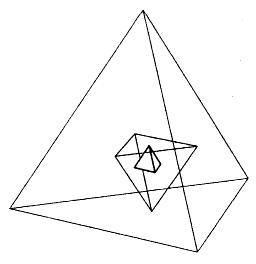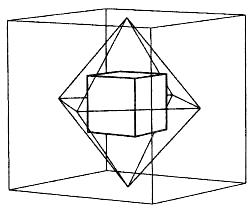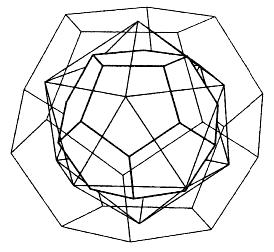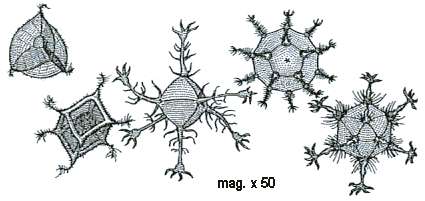- You have a symmetry homework due.
- Division homework is returned.
- The first two were to be done with the multiplication table;
- The second two with the unit fraction table.
- The first was easy.
- The second required more work. Some of you
repeated 1/52 -- no repeated unit fractions allowed!
I want to demonstrate a faster way, but one that requires more cleverness.... 7/13
- We have a test coming up next week, Thursday. More details next time.
- You have a reading assignment for next time -- applications of graphs.
- Platonic
solids possess a great deal of symmetry: they're
super-symmetric solids.
A Platonic solid is a solid for which
- All faces are congruent (identical) convex regular polygons, and
- Each face, each edge, and each vertex is exactly equivalent to every other face, edge, or vertex (respectively).
The Five Convex Regular Polyhedra (Platonic solids) -- thanks Wikipedia! Tetrahedron Hexahedron
or CubeOctahedron Dodecahedron Icosahedron 




- Last time we used our Platonic solids to fill in the
following table (use symmetry!):
# of Vertices Edges Faces faces at each vertex sides at each face Tetrahedron 4 6 4 3 3 Cube 8 12 6 3 4 Octahedron 6 12 8 4 3 Dodecahedron 20 30 12 3 5 Icosahedron 12 30 20 5 3 What conclusions can we draw from this data? Is there a pattern? (Of course there is!:) The pattern leads to the concept of "Duality":
- Each Platonic solid has a "twin" -- called its dual -- which we can discover from the table.

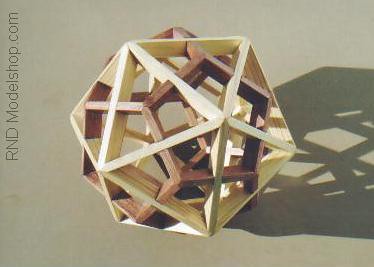
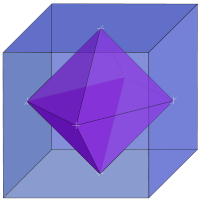
"In the Hindu tradition, the icosahedron represents purusha, the male, spiritual principle, and generates the dodecahedron, representing prakriti, the female, material principle."
- Each Platonic solid has a "twin" -- called its dual -- which we can discover from the table.
- What can you do with these solids?
- Play basketball? Three Sides to This Story: Knicks Dust Off
Phil Jackson's Triangle Offense, from the New York Times:

- Map the Earth?


The Platonic solids allow us to make "flat spheres" (sort of!):
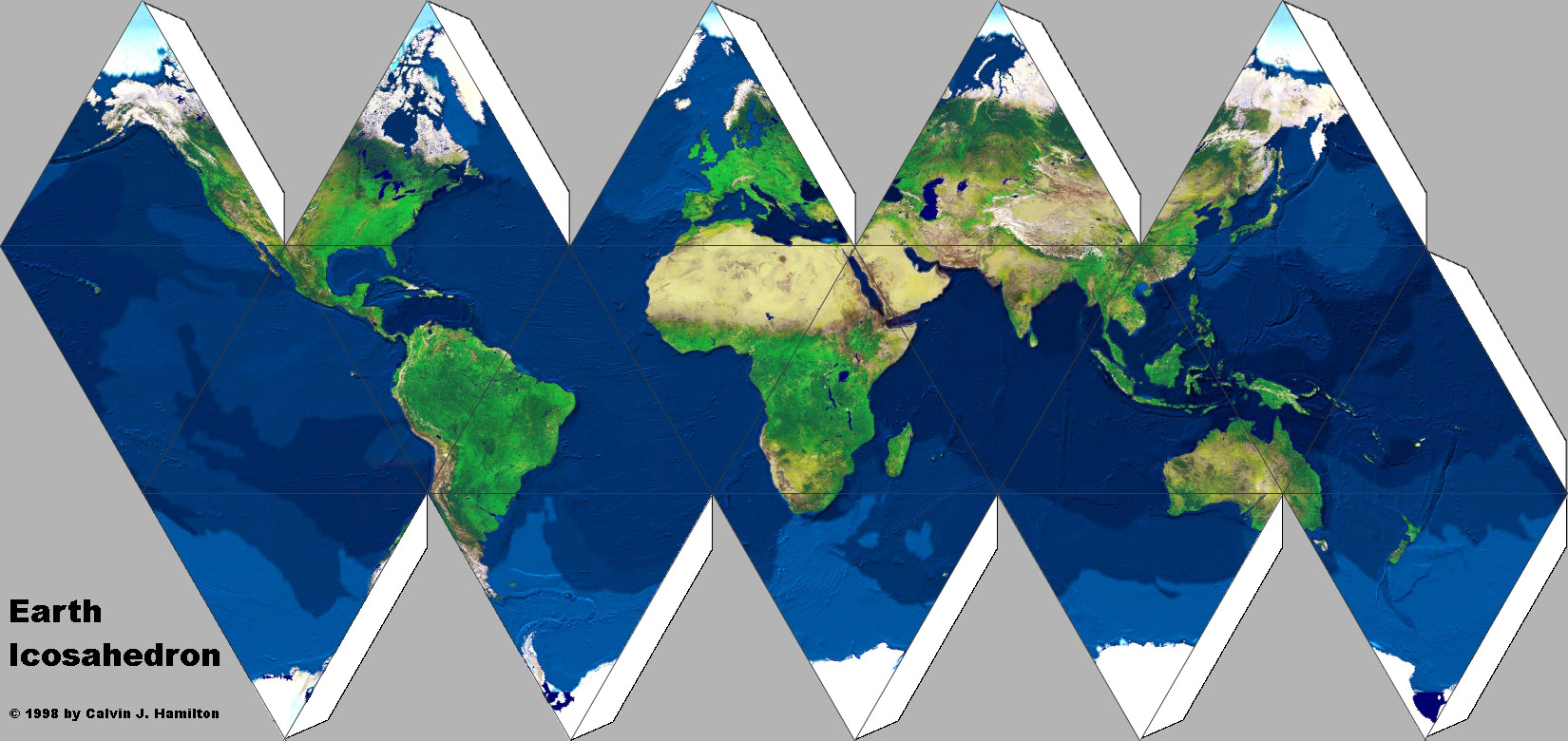
- Johannes Kepler thought that the orbits of the planets (of which
five were known at the time) were somehow related to the various
Platonic solids, as shown in
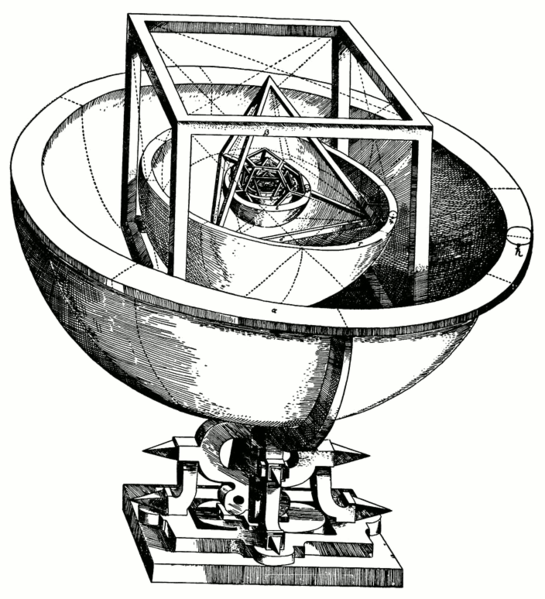
"The six spheres each corresponded to one of the planets (Mercury, Venus, Earth, Mars, Jupiter, and Saturn). The solids were ordered with the innermost being the octahedron, followed by the icosahedron, dodecahedron, tetrahedron, and finally the cube. In this way the structure of the solar system and the distance relationships between the planets was dictated by the Platonic solids."
And then Uranus was discovered, and there was not sixth Platonic solid. And so science evolves....
- Something interesting to share: great images from Linus Pauling's and Roger Hayward's The Architecture of Molecules (a book created especially for young people, and based off of Pauling's article in the 1964 Proceedings of the National Academy of Sciences).
These are some higher quality images than my scans:
- Pastel
drawing of a compound of Molybdenum Dichloride. Interlocking
tetrahedra, making a cube with an octahedron inside. Oooohhhh
(and maybe even an Aaaahhhh)!
- Pastel
drawing of a Tantalum Halide cluster ion. 1964. An octahedron
inside an icosahedron!
- Pastel drawing of Sodium Dicadmide. 1964. (I don't know what to make of this one. It's just a cool thing.)
- Beautiful pictures!
- More Beautiful pictures!
- Pastel
drawing of a compound of Molybdenum Dichloride. Interlocking
tetrahedra, making a cube with an octahedron inside. Oooohhhh
(and maybe even an Aaaahhhh)!
- So what can you do with an icosahedron? Look like a super-brainy, cool scientist!
From the October 7th, 2011 New York Times
- Icosahedron
- amoeboid protozoa: Circogonia icosahedra
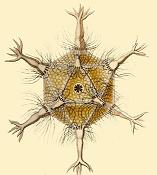
- Viruses:
- The Cliff Notes Version...

"An array of viruses. (a) The helical virus of rabies. (b) The segmented helical virus of influenza. (c) A bacteriophage with an icosahedral head and helical tail. (d) An enveloped icosahedral herpes simplex virus. (e) The unenveloped polio virus. (f) The icosahedral human immunodeficiency virus with spikes on its envelope."
- Bacteriophages and Virions
- The Cliff Notes Version...
- Dodecahedral Viruses:
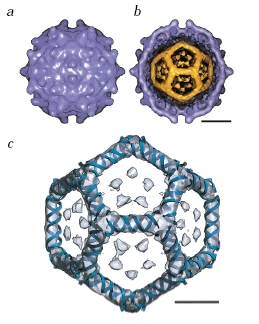
- amoeboid protozoa: Circogonia icosahedra
- More critters:
- Canine Parvovirus
- Enterobacteria Phage
-
Fig. 4.6 The platonic solids have been found living in the sea. The tetrahedron, somewhat rounded as if from internal pressure, is embodied in a protozoan called Callimitra agnesae, the cube is Lithocubus geometricus, the octahedron Circoporus octahedrus, the dodecahedron Circorrhegma dodecahedrus, and the icosahedron Circognia icosahedrus.
- Play basketball? Three Sides to This Story: Knicks Dust Off
Phil Jackson's Triangle Offense, from the New York Times:
- BuckminsterFullerene: a
relatively newly discovered form of carbon.
- How can we draw the Platonic solids on a sheet of paper? We project them onto the paper.
- The cube you've undoubtedly done before.
- The tetrahedron can be drawn to be a "distorted" Mercedes symbol
- The others are more complicated, and you've been asked to draw them for a homework.
- The Bridges
of Konigsberg problem: "is it possible to set off and walk around Konigsberg crossing each bridge exactly once?"


- Solved by Euler
(1735), the beginning of graph theory.
- Graphs are made up of vertices (points) and edges
that connect the vertices. More formally, a graph is defined as
- A collection of points, called vertices.
- A collection of edges, each of which connects two vertices.
- a set of rules, one for each edge, telling how each edge is connected to its pair of vertices.
- The degree of a vertex is the number of edges coming into it.
- Graphs are made up of vertices (points) and edges
that connect the vertices. More formally, a graph is defined as
- Euler's solution:
- Konigsberg: To be traversable, there must be at most two vertices of odd degree.
- Euler noticed the hand-shaking theorem: in any graph, the number of vertices with odd degree must be even.
- An alternative
solution -- thanks to spiked math
- Which of the Platonic solid graphs can be traversed without backtracking? (here they are)
- Solved by Euler
(1735), the beginning of graph theory.
- You've
probably been making graphs for a long time.... (the pentagram)
- Graphs don't change by bending edges, but breaking them or
detaching edges from their vertices (and hence creating new vertices)
gives new graphs.
- A graph is simple if it doesn't have any loops (edges connected
from a vertix to itself), or multiple edges with the same two vertices.
- Exercise: draw all the simple graphs with three
vertices. (We've done this before, when we were talking about Facebooks....)
- A cycle is a route from a node back to itself that doesn't retrace steps.
- One of these graphs is a tree: a graph that has no cycles.
- Where have we seen trees used before?
- Duality -- again!
- Exercise: draw all the simple graphs with four vertices.
- Have you ever seen any of these before? Could we give any of them names?
- Complete graphs are simply graphs with connections between
every pair of vertices (but no loops).
- Exercise: draw all the simple graphs with three
vertices. (We've done this before, when we were talking about Facebooks....)
- Planar graphs are graphs that can be drawn such that no two edges
intersect. Every Platonic
graph can be drawn this way, so they are planar graphs.
- We can show that the complete graph with four vertices is
planar.
- Exercise: Let's see if we can show that the complete graph
with five vertices is not planar:
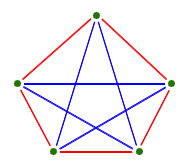
Why is the five vertex graph different? What happens?
- The three utilities and three houses graph is not planar:
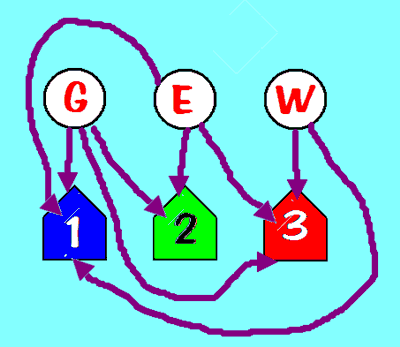
- Any non-planar graph has a copy of one of these two graphs
in it somewhere, as a subgraph:
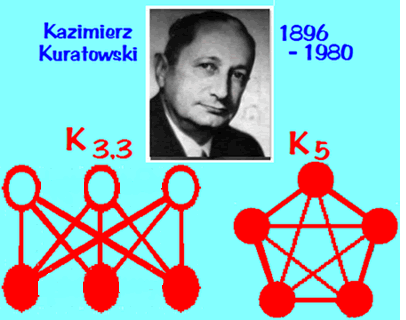
- We can show that the complete graph with four vertices is
planar.
- Konigsberg bridges page
- There are also "star Platonic solids", as we see in this lovely stellated dodecahedron.
- A lovely treatise on symmetry
- The "Spirograph" is a wonderful tool for making symmetric objects:
